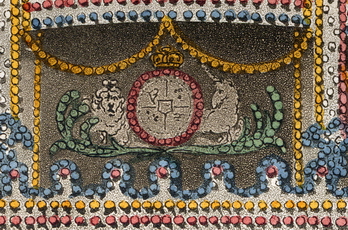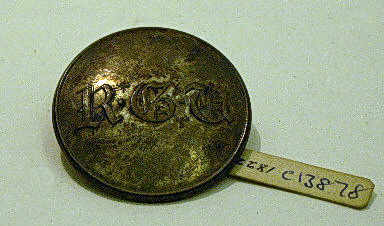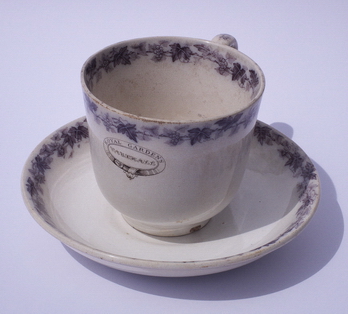|
Number 5. August 2016: A Vauxhall Dinner-plate
|
|
|
|
fig.1 |
|
This month's object, a blue-and-white transfer-printed pottery plate (fig.1), is currently on view at Fairfax House in York, loanes to their exhibition 'The Weird and the Wonderful: Entertaining Polite Georgian Society' (29 July - 31 December 2016). There, it is helping to represent the pleasure gardens of Georgian London, alongside other related exhibits, as well as the act of dining in public – something of a novelty to many Georgian families. |
|
fig.2 |
| The dinner-plate, 27cm (10½ inches) in diameter, is a very ordinary piece of Staffordshire earthenware, relatively cheaply produced at the time, and made for everyday use. It is one of the handful of survivors from many hundreds of such plates made for Vauxhall Gardens in around 1800. It has no marks whatever to identify its factory; the only characteristic that may point to its origin is the complete lack of a foot-rim on the base (fig.2). In its form and colour, it is totally unremarkable; however, the feature of this plate that sets it apart from all other antique blue-and-white earthenware is the subject of its decoration, which shows, within a circular border of ivy leaves and berries, a clear image of the second Vauxhall Orchestra building (unveiled in 1758, and demolished in 1859) set against trees, with a banner beneath reading 'VAUXHALL GARDENS' (fig.3). It is this design that gives the service from which this plate came its name of the Orchestra Service. The image of the Orchestra appears not to be directly derived from any existing print, but created specifically for this service. |
|
|
|
fig.3
|
| There is no direct evidence as to the numbers of wares ordered by Vauxhall, but during the auction sale run by Ventom and Hughes on 12 October 1841, following the bankruptcy of Frederick Gye and Richard Hughes (proprietors since 1821), a huge amount of crockery was sold. Lots 93 to 103 and 120 to 122 included 294 punch bowls, 895 plates, 677 dishes and 118 salad bowls. Whether these lots included any of the blue-and-white 'Orchestra' wares is not known, but these figures do give some idea of the quantities required for the catering operations at Vauxhall, bearing in mind that the crockery sold in 1841 would no doubt have been the survivors of several seasons' use, so much reduced from the original numbers. If all this crockery was sold in 1841, it poses the question of what was afterwards used for serving food, until the gardens closed in 1859. The only clue would be in the auction sale catalogue of 29 August 1859, run by Drivers; this sale is known from the advertising poster to have included 'China, Glass, Punch-bowls, Plates and Dishes, Decanters, Cruet-stands, and Glasses' but no detail is to hand because no catalogue of this sale appears to survive. |
| Even though Staffordshire glazed earthenware such as the Orchestra Service was relatively inexpensive at the beginning of the 19th century, the quantity ordered by Vauxhall's proprietors would have represented a major investment, to be made at a time of financial security and also at a date when the current proprietor felt that he would have time to make some reasonable return on his investment from the use of the service over several seasons. These factors help to suggest an approximate date for the manufacture of the service. The obvious times when conditions would have been conducive to this sort of capital expenditure are immediately following a change of ownership of the gardens, when a new proprietor may feel that new tableware could help to reinforce his re-branding and refurbishment. Stylistically, the most likely period of manufacture is during the 20 years either side of 1800, and the ownership of the gardens changed twice in that time - once following the death of Jonathan Tyers the younger in 1792, and once after the death of his son-in-law Bryant Barrett in 1809. The later date is more likely, judging by the detail in the image of the Orchestra. However, a date in the 1790s is not entirely impossible. |
| Despite the fact that the bulk of Vauxhall's pottery probably came from Staffordshire, it is known that local potteries either in Fulham or Lambeth were occasionally employed by the proprietors; this was not for the bulk of the crockery, which would have been too expensive to produce locally, but for brown salt-glazed stoneware mugs and tankards decorated with relief-moulded images of the Vauxhall Orchestra. Some examples of this are in the collection of the Museum of London, alongside several pieces of the Orchestra Service; a very nice stoneware jug with this Vauxhall decoration can be seen in Philip Mernick's December 2013 blog, as the 24th illustration. The only contemporary comment that we have about Vauxhall's tableware is associated with these wares. A manuscript fragment in the British Library, dated 29 August, 1859 reports that: |
|
The
first mugs with the Vauxhall Orchestra print were made by Bloodworth
a potter at Lambeth, but they were all short of measure, which some
lover of honesty caused the proprietors of the Royal Property to be
heavily fined. Bloodworth's mugs were withdrawn, and others of measure-gauge
made by Hill, whose pottery is now part of Northern's in Vauxhall Walk."
[MS piece in BL CUP 401 K7, f.421, Aug 29, 1859)
|
| The word 'print' in this quotation is misleading or a mistake – it cannot refer to the blue-and-white service because all the manufacturers mentioned are working too late for that, so it must refer to the relief-decorated stoneware mugs. Whether these brown wares were ever produced in large enough quantities for use in the gardens is not known, but I have never yet seen two the same. A brown-and-tan stoneware one pint beer-mug, possibly one of those made by Hill to replace Bloodworth's short-measures, is preserved in the Museum of London [63.37]; it is merely stamped 'Vauxhall Gardens', with no other decoration or mark, and was apparently "taken on the last night, 1859", presumably as a final souvenir. |
| Vauxhall's Orchestra Service was in daily use, possibly for more than a decade in the largest public catering operation in Georgian England. The evidence for its regular use at the gardens, rather than as a commercially-available service or souvenir, appears in the manuscript catalogue (written c.1837-1841) of the collection of Henry Syer Cuming (1817-1902), founder of the Cuming Museum in Southwark, who would have known Vauxhall Gardens; Cuming's ethnographic and antiquarian collection (much of which had been acquired by his father, Richard, who died in 1870 aged 93) included a punch-bowl and a plate from this service, which he recorded had been 'formerly used in the Vauxhall Gardens,' which he presumably knew from first-hand experience. Following a theft at the museum in 1992, the present whereabouts of these two items is unknown, but I saw them there in the 1970s, and they were certainly of the same pattern as my plate. Henry Cuming gives the date for these wares as 1796, but without any supporting evidence, although again maybe from first-hand knowledge. The Cuming Museum today holds a small collection of Vauxhall-related objects, including a piece of the great gilded wooden chandelier from the Vauxhall Rotunda (C 9436), a fragment of an old elm tree from the Gardens (C 11575), and a silvered copper button from a waiter's red uniform, with the monogram 'RGV' in Old English capitals (C 13878). |
 |
|
fig.4
|
| In the decoration of the plate the Orchestra is shown as it would have looked in around 1800-1810. The basic form of the Orchestra had not altered significantly since 1758; however, here it is decorated, over the sounding-board, with the royal coat-of-arms, and, in front of the dome, with the Prince of Wales's feathers. The only topographical views which show the royal arms in this position are the Rowlandson aquatint of the front of the Orchestra of 1809 [see detail, fig.4], and an anonymous night-time view in the Victoria & Albert Museum, London, of 1803 . Neither of these includes the Prince of Wales feathers on the front of the dome, although the V&A print does show them surmounting the royal arms; however, their inclusion on the plate confirms that it pre-dates the death of King George III and the accession of George IV in 1820, after which there was no Prince of Wales until 1841. |
|
|
|
fig.5.
Cuming Museum; reproduced by courtesy of the London Borough of Southwark
|
|
The
years immediately preceding 1820 are unlikely candidates for the date
of the plate, because 1816, 'the year without a summer' saw an unprecedented
overall loss for the proprietors of £3,000, and the subsequent
year or two were not much better. From 1818, in any case, the great-grandsons
of Jonathan Tyers were doing their best to sell the gardens, so would
be unlikely to be undertaking any major capital expenditure. Under Vauxhall's
new managers, who had taken on the lease in 1821, the year 1822 saw
a major alteration to the status of Vauxhall, when the proprietors obtained
from King George IV the royal warrant and permission to rename Vauxhall
as "The Royal Gardens, Vauxhall". From this time until the
final closure in 1859, every item in the public eye was re-branded with
this new title, from advertising posters and tickets, song-books and
programmes, all the way down to the monogram 'RGV' on the waiters' buttons
[fig.5]. It is impossible that an important item like the in-house crockery
would escape such a universal re-branding, so, with its simple caption
of 'Vauxhall Gardens,' it has to pre-date 1822, probably by at least
a decade. For all these reasons, a manufacture date of 1795-1810 is
not just likely, but almost certain, and this span includes Cuming's
date of 1796.
|
|
|
|
fig.6
|
| The fact that Cuming says in 1841 they were 'formerly' used at the gardens may suggest that the service had already been replaced with another that proclaimed the new title of 'Royal Gardens, Vauxhall' after 1822. The tea-cup and saucer I acquired from the Driver family, descendants of the auctioneers who ran the final disposal sales of Vauxhall Gardens in August 1859 (fig.6) is the only clue we have to how this later service might have looked; currently, this is the only known example of this pattern. |
| The Orchestra Service survives in several shapes, including not only dinner plates, but also punch bowls, salad bowls, tankards or mugs (two examples in the Museum of London [70.111 and A20590]) and large oval serving dishes (one example known in a private collection, UK). Though it was manufactured in bulk, it is inevitable that much of the pottery made for Vauxhall would have been lost due to breakages, well before the gardens closed in 1859. Breakages and thefts of such wares are unavoidable in any large catering organisation, whether by customers, waiters, or kitchen staff, so the survivors of this service are fortunate, even though most of them show signs of heavy wear – they are almost always stained, chipped, cracked, and crazed. This particular plate has half-a-dozen chips around the edge, made at different stages of its life, as well as a small firing fault, but it is clear that none of this precluded its continued use at the gardens, or its eventual removal from them, whether by sale or in somebody's pocket |
| The crockery in use at Vauxhall previous to the blue-and-white Orchestra Service is totally unknown, and does not appear to survive, or else has not been recognised. We know from an early description in the Scots Magazine I, of September 1739 [p.409] that glass and china were indeed used from early in the proprietorship of Jonathan Tyers the elder: |
|
Glass
candlesticks with wax lights are mostly used; and, with the addition
of the china dishes, plates, &c. in which every thing is served up,
greatly increase the beauty and elegance of the cover'd tables. - I
must confess when this custom of supping before the publick first came
in fashion, I was far from approving it: but powerful use has familiarized
it; and we are now no more surprised to behold a young Lady dissect
a pigeon, or swallow a plate of ham before three thousand people, than
to see her take a pinch of snuff at church.
|
| No more detailed description of these plates and dishes survives, so we are left to guess at their appearance. The only possible clue is in a large (42.3cm/16½inch diameter) round dish in tin-glazed earthenware, hand-painted and sponged with a view of the Grand South Walk at Vauxhall Gardens, based on the engraving of the same subject by J.S. Muller after a drawing by Canaletto (1751). This plate, now in the Bristol City Museum and Art Gallery [N.3781]. Currently on display, Gallery 1, is most likely to have been a private commission for a wealthy individual, but it may also be a unique survivor of a bigger service once used at the gardens. If it was, then the designer of the 19th century Orchestra service was following a long tradition of decorating Vauxhall's crockery with Vauxhall views. |
| Next month, I'll be putting some food on this plate, by investigating the expensive refreshments for which these plates were made, by way of an original Bill of Fare from 1823. |
| Back |
| [If you would like to comment on this article, please contact me] |

